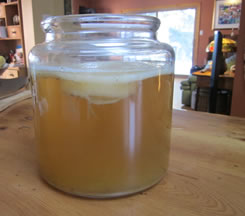Nutra Ingredients USA – Study at https://ow.ly/42FNv – Vitamin D linked to colon cancer protection
Bromine Toxicity and Hyperthyroidism
Dr. David Brownstein – whose blogs I follow – posted this information today. I’ve just added in some nutritional information for your health!
Recently, the U.S. EPA reported that common chemicals (polybrominated diphenyl ethers– PBDE’s) found in nearly all our homes are contributing to a rash of thyroid problems. This class of chemicals is mainly used as a fire-retardant. PBDE’s are also found in a variety of household items including computers, televisions, carpeting, furniture and mattresses. PBDE’s are made from bromine. Bromine is also used to keep swimming pools and hot tubs clean. It is used as a pesticide, as well as in brominated vegetable oil which is used as an emulsifier in many citrus flavoured soft-drinks. (Source: https://en.wikipedia.org/wiki/Bromine)
Bromine is from the family of halides. This chemical family contains iodine, fluoride and chlorine as well. The reason we are seeing such a high prevalence of iodine deficiency and thyroid disorders in humans is due, in large part, to the excess exposure of bromine from our modern conveniences. Bromine exposure causes our bodies to excrete iodine. If we don’t supplement with extra iodine, bromine will bind to receptors in the body that are supposed to be binding with iodine. In effect, bromine will replace iodine throughout the body.
What are the consequences of excess bromine levels?
The consequences are severe; increased rate of cancer of the breast, thyroid, ovaries, uterus and prostate are due, in part, to bromine toxicity. Also, we are seeing dramatically increased rates of autoimmune illnesses including autoimmune thyroid disorders. People with a serious illness have markedly elevated bromine levels.
So, what can you do?
The main treatment for excess bromine is to avoid bromine exposure. Eat foods that do not contain bromine such as organic fruits and vegetables. Avoid bread, pasta and cereal that contain brominated flour and citrus-flavoured soft drinks like Mountain Dew. Next, supplement with enough iodine to allow your body to detox from bromine – excellent food sources of iodine include sea vegetables (sea vegetables like dulse, kombu, kelp can be added to your cooking water, and soups and stews, and you can sprinkle it on top of food to replace salt – for more recipes, visit https://www.whfoods.com).
Finally, supplement with antioxidants like Beta Carotene, vitamins C and E, selenium and zinc that help your detoxification system function optimally. It’s easy to recognize foods rich in antioxidants because they have the brightest colours. Enjoying a spectrum of different coloured foods will allow you to enjoy the benefits of a spectrum of antioxidants.
Incoming search terms:
- bromine poisoning from hot tub
Kombucha – detoxifying drink
Supplemental Vitamin D important during the winter
Last week I was asked to write a monthly nutrition article for one of my good friends and client for many years, Lee of WoW Power Walking. At first I was quite nervous about the idea, but then realized that this is a great opportunity for me to start walking my talk. Or at least starting on that journey. Below is the first article that I’ve submitted to her for next month’s newsletter. If anyone has suggestions for the next article or articles, please let me know. And please feel free to pass along this article to anyone you feel could use the information.What is Vitamin D? What does it do?Vitamin D is the “sunshine” vitamin, manufactured from cholesterol in the human skin when in comes in contact with UVB radiation from the sun. It regulates the body’s absorption of calcium and phosphorus making it crucially important for the maintenance of bone density, healthy bones and teeth, and the normal function of the nervous system. Without sufficient vitamin D, taking calcium supplements is useless.How do we get it?From March to early Fall, there is sufficient UVB radiation from the sun to provide adequate amounts of Vitamin D to our bodies. However, from October until March there is not enough UVB radiation reaching the Toronto area to enable our bodies to synthesize Vitamin D, so we need to consider supplementation – whether through diet or a dietary supplement.Vitamin D production is further blocked when we apply sunscreen to our bodies. According to the Linus Pauling Institute, “the application of sunscreen with an SPF factor of 8 reduces production of vitamin D by 95%.” How do we get around this? Moderate, limited sun exposure of 10-15 minutes daily – without sunscreen – during the spring, summer and fall, from 11am to 2pm, on the face and arms, will provide enough UVB radiation for the individual to synthesize sufficient vitamin D. Are there food sources available?There are few natural food sources of vitamin D, but some excellent options include shrimp, sardines, cod and eggs (from World’s Healthiest Foods). It’s also available in mushrooms and dark leafy green vegetables such as kale, collard greens, and spinach. A vast amount is also manufactured synthetically and added to bread, milk and other fortified foods.Bottom line then is even when you’re enjoying the benefits of fresh air and sunshine during your winter walks, you’re actually not able to use the sun’s energy to make vitamin D because it isn’t strong enough. From October until March (or from Halloween until March break for all you Mom’s!), supplement with a daily dose of vitamin D or make sure that you’re eating fish and greens each week. My teens enjoy their morning spritz of D-day by Biocare (a Canadian manufacturer).

